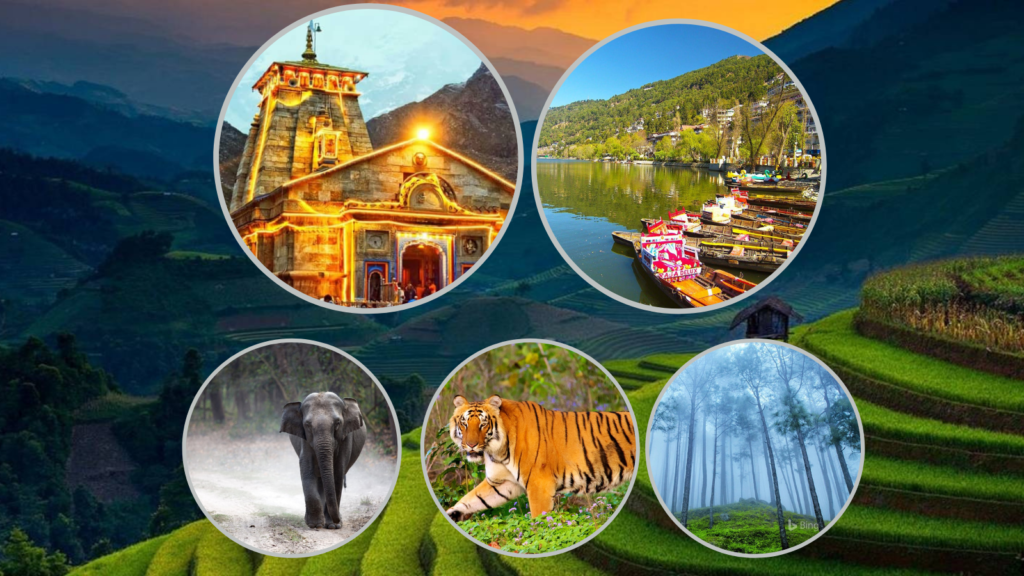Why is Uttarakhand famous for tourism?
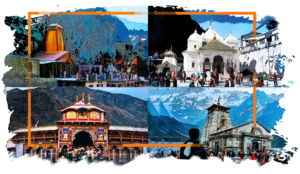
Uttarakhand, nestled in the lap of the Himalayas, is a breathtaking state in northern India that boasts an enchanting blend of natural beauty, spiritual significance, and cultural richness. Renowned for its pristine landscapes, the region is home to some of the most majestic peaks, including the sacred Gangotri and Yamunotri, the sources of the Ganges and Yamuna rivers. Uttarakhand is a haven for nature lovers, offering lush green valleys, dense forests, and meandering rivers, providing a serene escape from the hustle and bustle of city life.
The state is also a pilgrimage destination, with famous temples like Badrinath, Kedarnath, and Hemkund Sahib attracting devotees from far and wide. These sacred sites not only hold religious significance but are also surrounded by awe-inspiring natural beauty. Uttarakhand is dotted with numerous charming towns and villages, each with its own unique cultural heritage and traditions.
Adventure seekers flock to Uttarakhand for its thrilling trekking trails, white-water rafting opportunities, and snow-covered slopes for skiing. The Jim Corbett National Park, India’s oldest national park, offers a chance to witness the diverse wildlife of the region, including the elusive Bengal tiger.
The hospitality of the local communities adds to the overall allure of Uttarakhand tourism. Visitors can experience the warmth of the people, savor local cuisine, and participate in cultural festivities that celebrate the state’s rich heritage. Whether seeking spiritual solace, embarking on an adventure, or simply indulging in the tranquility of nature, Uttarakhand is a destination that leaves a lasting impression on every traveler.
Uttarakhand’s charm extends beyond its natural and spiritual offerings. The state is known for its vibrant fairs and festivals that showcase the cultural diversity of the region. The Kumbh Mela, held in Haridwar, is one of the largest religious gatherings in the world, attracting millions of pilgrims who come to bathe in the holy Ganges. The Nanda Devi Raj Jat Yatra, a traditional pilgrimage that takes place once every twelve years, is another highlight, drawing devotees and trekkers alike to the high-altitude regions.
The capital city, Dehradun, serves as a gateway to the Garhwal region and is a blend of colonial architecture and modern amenities. Mussoorie, often referred to as the “Queen of Hills,” is a popular hill station with its scenic landscapes and pleasant weather, making it a favored retreat for tourists.
Uttarakhand is also known for its yoga and wellness centers, attracting those seeking spiritual rejuvenation and holistic healing. Rishikesh, situated on the banks of the Ganges, is renowned as the “Yoga Capital of the World,” offering a serene environment for yoga and meditation practices.
The state’s handicrafts, including woodwork, handloom textiles, and traditional jewelry, showcase the skilled craftsmanship of the local artisans. Shopping in the bustling markets of cities like Nainital and Almora provides an opportunity to take home souvenirs that reflect Uttarakhand’s cultural richness.
In winter, the snow-clad landscapes of Auli and Munsiyari transform into winter wonderlands, attracting skiing enthusiasts and nature lovers. The Auli Ski Resort is a sought-after destination for adventure seekers looking to experience the thrill of snow sports against the backdrop of the majestic Himalayas.
Uttarakhand, with its diverse offerings and warm hospitality, stands as a testament to the unparalleled beauty and cultural wealth that northern India has to offer, making it a must-visit destination for those seeking a holistic travel experience.
Pilgrimage Destinations
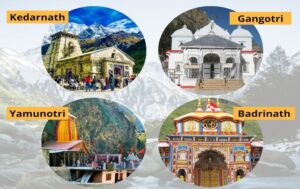
Definition: Char Dham Yatra refers to the pilgrimage to the four holy shrines, namely Yamunotri, Gangotri, Kedarnath, and Badrinath, situated in the state of Uttarakhand.
Significance: The Char Dham holds immense religious significance in Hinduism, and undertaking this journey is believed to wash away sins and lead to salvation (moksha).
Located in the Garhwal Himalayas, it is the source of the Yamuna River.
Pilgrims take a trek to Yamunotri to worship
the goddess Yamuna.
Yamunotri is situated in the Garhwal Himalayas at an altitude of approximately 3,293 meters (10,804 feet) above sea level.
It is one of the Char Dham pilgrimage sites
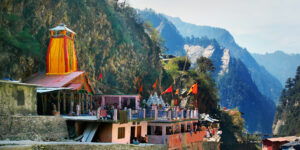
in Hinduism, along with Gangotri, Kedarnath, and Badrinath.
The main attraction is the Yamunotri Temple, dedicated to Goddess Yamuna, the goddess of the Yamuna River.
The temple is believed to be built by Maharani Guleria of Jaipur in the 19th century.
Pilgrims trek to the temple to seek the blessings of Goddess Yamuna.
Situated in Uttarkashi, it marks the origin of the Ganges River.
Pilgrims visit the Gangotri temple dedicated to Goddess Ganga.
Gangotri is located in the Garhwal Himalayas at an altitude of approximately 3,100 meters (10,200 feet) above sea level.
It is one of the Char Dham pilgrimage sites in Hinduism, along with Yamunotri, Kedarnath, and Badrinath.
The main attraction is the Gangotri Temple, dedicated to Goddess Ganga, the goddess of the Ganges River.
The temple was built in the 18th century by Amar Singh Thapa, a Gorkha commander.
Gangotri is considered the origin of the Ganges River, one of the holiest rivers in Hinduism.
The Ganges, also known as the Bhagirathi here, is formed by the confluence of the Bhagirathi and Alaknanda rivers at Devprayag.

Nestled in the Rudra Himalayas, it is dedicated to Lord Shiva.
Pilgrims trek or use other means to reach Kedarnath, one of the twelve Jyotirlingas.
Kedarnath is situated at an altitude of approximately 3,583 meters (11,755 feet) above sea level.
It is one of the Char Dham pilgrimage sites in Hinduism, along with Badrinath, Gangotri, and Yamunotri.
The main attraction is the Kedarnath Temple, dedicated to Lord Shiva as Kedareshwar.
The temple is believed to have been constructed by Adi Shankaracharya in the 8th century.
Kedarnath is situated near the headwaters of the Mandakini River, a tributary of the Alaknanda River.
The Mandakini River originates from the Chorabari Glacier, near Kedarnath.

Located in the Chamoli district, it is dedicated to Lord Vishnu.
The Badrinath temple is one of the 108 Divya Desams and a significant Char Dham site.
Badrinath is located at an altitude of approximately 3,133 meters (10,279 feet) above sea level.
It is one of the Char Dham pilgrimage sites in Hinduism, along with Kedarnath, Gangotri, and Yamunotri.
The main attraction is the Badrinath Temple, dedicated to Lord Vishnu as Badrinarayan.
The temple is one of the 108 Divya Desams, considered sacred by followers of the Vaishnavism tradition.
Badrinath is situated near the confluence of the Alaknanda and Saraswati rivers.
The Alaknanda River, one of the main tributaries of the Ganges, originates near Badrinath.
Wildlife Sanctuaries and National Parks

Jim Corbett National Park
India’s oldest national park, established in 1936.
Located in the Nainital district.
Known for its significant population of Bengal tigers.
Diverse wildlife includes elephants, leopards, deer, and various bird species.
Offers jeep safaris, elephant safaris, and bird watching.

Valley of Flowers National Park
A UNESCO World Heritage Site.
Situated in the Chamoli district.
Famous for its alpine flowers, especially during
the monsoon season.
Home to a variety of plant species, including rare and endangered ones.
Provides stunning views of the surrounding mountains.

Nanda Devi National Park
A UNESCO World Heritage Site.
Located in the Chamoli and Pithoragarh districts.
Encompasses the Nanda Devi peak, the second-highest mountain in India.
Rich biodiversity with diverse flora and fauna.
Trekking is a popular activity in the surrounding areas.

Rajaji National Park
Spans across the districts of Haridwar, Dehradun, and Pauri Garhwal.
Named after C. Rajagopalachari, a prominent freedom fighter.
Home to diverse wildlife, including elephants, tigers, leopards, and deer.
Offers opportunities for wildlife safaris and bird watching.
Hill Stations
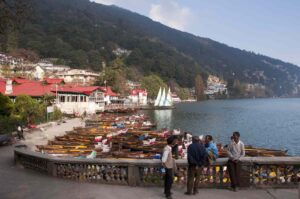
Nainital is a popular hill station located in the Kumaon region of Uttarakhand, India.
Situated at an altitude of approximately 2,084 meters (6,837 feet) above sea level.
The town is set d after Naini Lake, which is a central attraction.
The lake is surrounded by hills and offers boating facilities to visitors.
Naina Devi Temple, dedicated to Goddess Naina, is located on the northern shore of the lake.
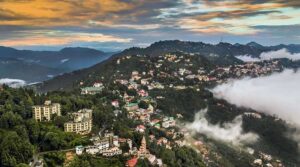
Mussoorie is a popular hill station located in the Dehradun District of Uttarakhand, India.
Situated at an average altitude of around 1,880 meters (6,170 feet) above sea level.
Mussoorie is often referred to as the “Queen of Hills.”
Renowned for its scenic beauty, pleasant climate, and panoramic views of the Himalayan range.
The Mall Road in Mussoorie is a bustling street lined with shops, cafes, and colonial architecture.
A favorite spot for leisurely walks and shopping.

Ranikhet is a charming hill station located in the Almora district of Uttarakhand, India.
Situated at an altitude of around 1,869 meters (6,132 feet) above sea level.
The name “Ranikhet” translates to “Queen’s Meadow” in English.
Popularly believed to be named after Queen Padmini, who fell in love with the scenic beauty of the region.
Ranikhet is a cantonment town and home to the Kumaon Regiment of the Indian Army.
Maintains a clean and well-maintained environment.
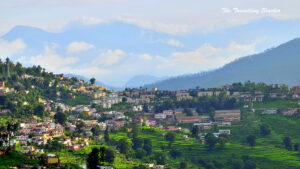
Almora is a captivating hill station and district headquarters located in the Kumaon region of Uttarakhand, India.
Situated at an average elevation of about 1,638 meters (5,374 feet) above sea level.
Almora is known for its rich cultural heritage and traditional Kumaoni architecture.
The town holds historical and cultural significance dating back to ancient times.
Surrounded by pine and oak forests, offering panoramic views of the Himalayan peaks.
The town is situated on a horse-shaped ridge, enhancing its natural beauty.
Ancient Temples

Kedarnath Temple
Dedicated to Lord Shiva.
One of the twelve Jyotirlingas.
Located in the Garhwal Himalayas.
Accessible through a challenging trek or helicopter ride.

Badrinath Temple
Dedicated to Lord Vishnu.
One of the Char Dham pilgrimage sites.
Situated in the Chamoli district.
Features intricate architecture and is surrounded by scenic beauty.

Yamunotri Temple
Dedicated to Goddess Yamuna.
Part of the Char Dham Yatra.
Located at the source of the Yamuna River.
Accessible through a trek.

Gangotri Temple
Dedicated to Goddess Ganga.
One of the Char Dham pilgrimage sites.
Positioned in the Uttarkashi district.
Sits at the origin of the Ganges River.
Rivers
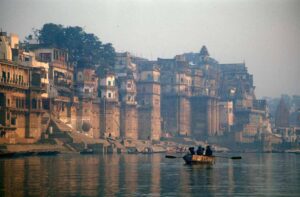
Ganges (Ganga)
Originates from Gangotri in Uttarakhand.
Flows through major towns like Rishikesh and Haridwar.
Considered one of the holiest rivers in Hinduism.
Offers opportunities for river rafting and pilgrimage.
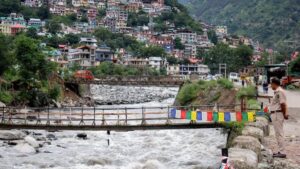
Originates from Yamunotri in the Garhwal Himalayas.
Merges with the Ganges at Allahabad.
Important river in Hindu mythology.
Provides a serene environment along its course.
Originates from the confluence of Satopanth and Bhagirathi.
Merges with the Bhagirathi at Devprayag to form the Ganges.
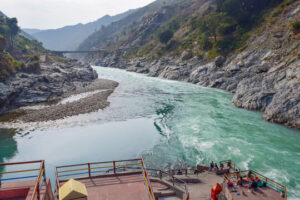
Flows through the scenic Alaknanda Valley.
Devprayag is the sacred confluence point where the Alaknanda River meets the Bhagirathi River.
It marks the beginning of the Ganges River from this point onward.
Saraswati (Sarasvati)
A tributary of the Alaknanda River.
Joins the Alaknanda at Mana village.
Mythologically significant river mentioned in ancient texts.
Saraswati is revered as the goddess of learning, music, and the arts.
The symbolism of the Saraswati River represents the flow of knowledge and the pursuit of wisdom.
1.What is special of Uttarakhand?
Uttarakhand, often referred to as the “Devabhumi” or “Land of the Gods,” is a state in northern India known for its diverse and unique attractions. Some of the special features and highlights of Uttarakhand include:
- Spiritual Significance: Uttarakhand is home to numerous pilgrimage sites that hold great spiritual significance for Hindus. The Char Dham (Yamunotri, Gangotri, Kedarnath, and Badrinath) pilgrimage circuit attracts millions of devotees each year. Other sacred destinations include Haridwar, Rishikesh, Hemkund Sahib, and Panch Kedar.
- Himalayan Landscapes: The state is renowned for its breathtaking Himalayan landscapes, including snow-capped peaks, verdant valleys, meandering rivers, and dense forests. Uttarakhand offers stunning vistas and opportunities for trekking, mountaineering, and adventure sports.
- Yoga Capital of the World: Rishikesh, situated on the banks of the Ganges River, is known as the “Yoga Capital of the World.” It attracts spiritual seekers and yoga enthusiasts from around the globe who come to learn and practice yoga and meditation in its serene surroundings.
- Rich Biodiversity: Uttarakhand boasts rich biodiversity with diverse flora and fauna. The state is home to several wildlife sanctuaries and national parks, including Jim Corbett National Park, Rajaji National Park, and Valley of Flowers National Park, which offer opportunities for wildlife viewing and nature exploration.
- Cultural Heritage: Uttarakhand has a rich cultural heritage with diverse traditions, languages, and folk art forms. The indigenous communities, such as the Garhwalis and Kumaonis, have their own distinct cultural practices, music, dance, and festivals.
- Hill Stations: Uttarakhand is dotted with picturesque hill stations such as Nainital, Mussoorie, Almora, and Ranikhet, which offer panoramic views of the Himalayas and pleasant weather. These hill stations are popular tourist destinations, especially during the summer months.
- Adventure Tourism: The state offers a wide range of adventure activities, including trekking, white-water rafting, skiing, paragliding, and rock climbing. Adventure enthusiasts flock to destinations like Auli, Chopta, Rishikesh, and Jim Corbett National Park for adrenaline-pumping experiences.
2.What is the most famous thing of Uttarakhand?
The most famous thing about Uttarakhand is its spiritual significance and pilgrimage sites. Uttarakhand is often referred to as the “Devabhumi” or “Land of the Gods” due to its association with numerous sacred destinations and pilgrimage circuits. The Char Dham pilgrimage circuit, which includes Yamunotri, Gangotri, Kedarnath, and Badrinath, attracts millions of devotees and pilgrims from across India and around the world.
These pilgrimage sites hold immense religious significance in Hinduism, as they are believed to be the abodes of various deities and are visited by devotees seeking spiritual blessings and purification. Apart from the Char Dham, Uttarakhand is also home to other important pilgrimage destinations such as Haridwar, Rishikesh, Hemkund Sahib, and Panch Kedar.
The spiritual aura, cultural heritage, and sacredness associated with these pilgrimage sites make them the most famous aspect of Uttarakhand, drawing visitors seeking spiritual solace, enlightenment, and divine experiences.
3.What is the short note on tourist place of Uttarakhand?
Tourist Places in Uttarakhand:
Uttarakhand, nestled in the lap of the Himalayas, offers a plethora of enchanting destinations that cater to diverse interests. From spiritual retreats to adrenaline-pumping adventures, Uttarakhand has something for everyone.
- Pilgrimage Sites: Uttarakhand is renowned for its sacred pilgrimage sites like the Char Dham (Yamunotri, Gangotri, Kedarnath, and Badrinath) and revered towns like Haridwar and Rishikesh, which attract millions of devotees seeking spiritual solace and enlightenment.
- Hill Stations: The state boasts picturesque hill stations such as Nainital, Mussoorie, Almora, and Ranikhet, offering panoramic views of the Himalayas and pleasant weather, making them ideal destinations for a serene retreat amidst nature.
- Adventure Tourism: Uttarakhand is an adventurer’s paradise, offering opportunities for trekking, white-water rafting, skiing, paragliding, and mountaineering. Auli, Rishikesh, Chopta, and Jim Corbett National Park are some of the popular adventure hubs.
- Wildlife Sanctuaries and National Parks: The state is home to diverse wildlife sanctuaries and national parks, including Jim Corbett National Park, Rajaji National Park, and Valley of Flowers National Park, providing opportunities for wildlife enthusiasts to explore the rich biodiversity of the region.
- Yoga and Wellness: Rishikesh, the “Yoga Capital of the World,” attracts yoga enthusiasts and spiritual seekers from around the globe with its serene ambiance and plethora of ashrams offering yoga and meditation retreats.
- Cultural Heritage: Uttarakhand’s rich cultural heritage is reflected in its traditional festivals, art forms, and indigenous communities. The Garhwali and Kumaoni cultures add vibrancy to the state’s ethos, offering a glimpse into its rich cultural tapestry.

